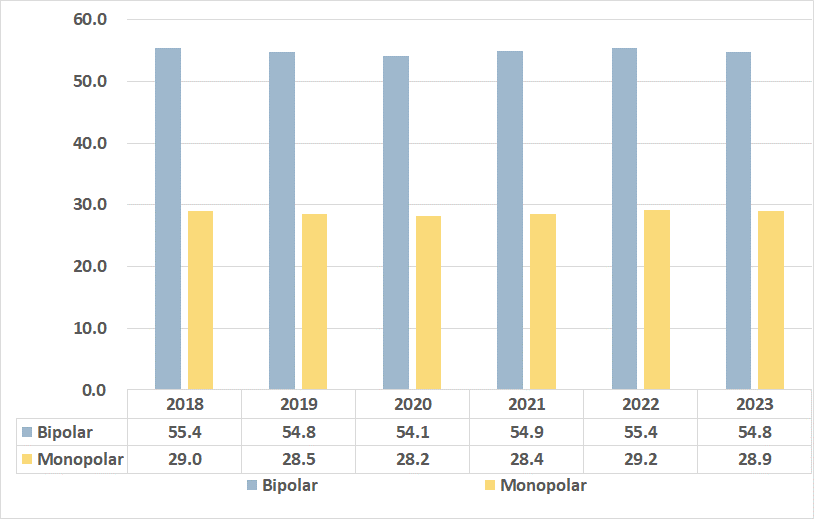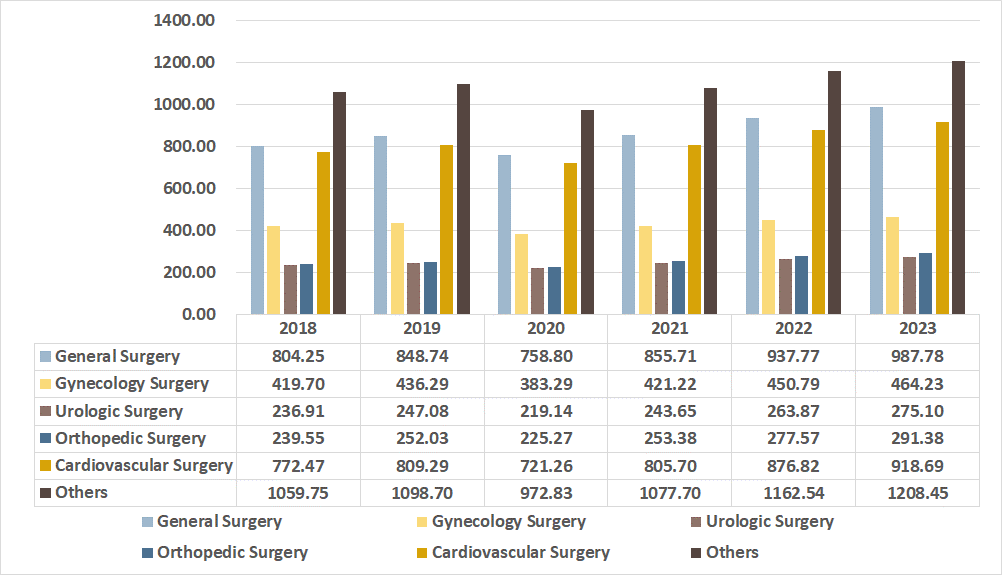1. Introduction of Electrosurgical Devices Market Types
Bipolar: Electrosurgical instruments can be roughly divided into two categories: monopolar and bipolar. These describe the path of the electrical current during surgery. Bipolar electrosurgery uses lower voltages so less energy is required. Bipolar electrosurgery eliminates the need for a dispersal pad. The electrosurgical instrument itself has an active electrode and a return electrode. These are usually the tips of a pair of forceps or scissors. Importantly, only the tissue between the instrument is affected by this circuit. This means that bipolar electrosurgery presents a decreased risk of burns. However, a bipolar configuration may limit the ability of tools to cut or coagulate when compared to monopolar electrosurgery, limiting its uses.
Monopolar: In monopolar electrosurgery, the active electrode is applied to patient tissue. The electrical current passes through the patient to a dispersal pad which is connected to the electrosurgical generator, where it is safely dissipated. Monopolar electrosurgery is the most commonly used electrosurgery modality due to its versatility, clinical effectiveness, and wider tissue effects. But it does present risks of burns due to equipment or operator malfunction. It may also be dangerous for patients with certain pacemakers or prosthetic devices.
2. Global Electrosurgical Devices Market Value Analysis by Types
The market value of monopolar devices has always been higher than that of bipolar devices from 2018 to 2023. In 2018, the market value of bipolar devices was $1207.58 million, while the market value of monopolar devices was $2325.04 million. By 2023, the market value of bipolar devices has grown to $1471.23 million, and the market value of monopolar devices has grown to $2674.39 million. The growth rate of the market value of monopolar devices is large, and bipolar devices also show stable growth. This shows that monopolar electrosurgical devices are becoming more and more popular in the global market, and the market value is increasing year by year.
Figure Global Electrosurgical Devices Value (M USD) Segment by Type from 2018-2023

3. Global Electrosurgical Devices Market Production Analysis by Type
The production volume of unipolar devices has been higher than that of bipolar devices from 2018 to 2023. In 2018, the production volume of bipolar equipment was 21791 thousand units and unipolar equipment was 80298 thousand units. By 2023, the production volume of bipolar devices will increase to 26866 thousand units, while that of monopolar devices will increase to 92466 thousand units. The production volume of monopolar equipment has increased significantly, and bipolar equipment has also shown steady growth. This shows that monopolar electrosurgical devices are becoming more and more popular in the global market, and production volumes are increasing year by year.
Table Global Electrosurgical Devices Production (K Units) by Type (2018-2023)
|
|
2018 |
2019 |
2020 |
2021 |
2022 |
2023 |
|
Bipolar |
21791 |
23174 |
20917 |
23504 |
25285 |
26866 |
|
Monopolar |
80298 |
84843 |
76051 |
83240 |
87859 |
92466 |
|
Total |
102089 |
108017 |
96968 |
106745 |
113145 |
119331 |
4. Global Electrosurgical Devices Market Price Analysis by Type
From 2018 to 2023, the unit price of bipolar devices has always been higher than that of monopolar devices, but the unit prices of both devices have shown a downward trend year by year. In 2018, the unit price of bipolar devices was US$55.4/unit, while the unit price of monopolar devices was US$29.0/unit. By 2023, the unit price of bipolar devices has dropped to US$54.8/unit, and the unit price of monopolar devices has dropped to US$28.9/unit.
Figure Global Electrosurgical Devices Price (USD/Unit) by Type (2018-2023)

5. Introduction of Electrosurgical Devices Market Applications
General Surgery: General surgery includes a core knowledge of anatomy, physiology, metabolism, immunology, nutrition, pathology, wound healing, and other areas common to all surgical specialties. General surgeons have specialized knowledge and experience related to diagnosis and preoperative, operative, and postoperative management. General surgeons treat diseases related to the abdomen, breast, head and neck, blood vessels, digestive tract, injuries, deformities, and other conditions.
Gynecology Surgery: Gynecology surgery includes any surgical procedure that involves the organs and structure of the female pelvic region: the uterus, ovaries, cervix, fallopian tubes, vagina and vulva. Women may need surgery from an OB-GYN at different times in their lives for many different reasons. A younger woman may need ovarian cysts or fibroids removed to be able to get pregnant. An older woman may need a hysterectomy. Surgery can be used to address pelvic pain from endometriosis and abnormal bleeding in the uterine cavity. Surgery may be also needed to remove a failed pregnancy or to prevent another pregnancy from happening. Gynecological cancer is another common reason for surgery.
Urologic Surgery: Urology is a part of health care that deals with diseases of the male and female urinary tract (kidneys, ureters, bladder, and urethra). It also deals with the male organs that can make babies (penis, testes, scrotum, prostate, etc.). Since health problems in these body parts can happen to everyone, urologic health is important. Urologic surgery focuses on operations of the urinary tract and the reproductive system. Urologic surgery treats conditions of male reproductive organs, such as prostate cancer; male and female urinary tract, such as kidney or bladder cancer.
Orthopedic Surgery: Orthopedic surgery is a procedure on your musculoskeletal system. It can diagnose, treat, repair, and prevent conditions that affect your bones, muscles, and joints. Once devoted to the care of children with spine and limb deformities, orthopedists now care for patients of all ages, from newborns with club feet to young athletes requiring arthroscopic surgery to older people with arthritis. And anybody can break a bone at any age. Common types of orthopedic surgery are ACL surgery and knee replacement surgery.
Cardiovascular Surgery: Cardiovascular surgery describes any surgical procedure that involves the heart, or the blood vessels that carry blood to and from the heart. These procedures are common with patients who have heart disease or have had a heart attack, stroke, or blood clot—as well as individuals who are at high risk for developing these problems. While cardiovascular surgery isn’t always necessary to treat heart problems, doctors may recommend it for a variety of reasons, including treating or preventing heart attacks and blood clots, addressing irregular heartbeats, opening blocked or narrowed arteries, repairing congenital heart problems, and fixing damaged or diseased heart valves. Some cardiovascular conditions require open surgery, but many are treated with less invasive techniques that use catheters and robotics.
6. Global Electrosurgical Devices Market Value Analysis by Applications
From 2018 to 2023, general surgery has always maintained the largest market share, and its growth rate is relatively stable. The general surgery market was valued at US$804.25 million in 2018 and will grow to US$987.78 million by 2023. The market value of gynecological surgery and urological surgery also showed steady growth during this period, but the growth rate was not as fast as that of general surgery. The market value of orthopedic surgery and cardiovascular surgery shows a more significant growth trend, especially the cardiovascular surgery market, which will grow from US$772.47 million in 2018 to US$918.69 million in 2023.
Overall, the market value of the electrosurgical equipment market in various application fields shows a stable or growing trend, reflecting the continued expansion and deepening of the demand for electrosurgical technology in medical operations.
Figure Global Electrosurgical Devices Value (M USD) Segment by Applications from 2018-2023

7. Global Electrosurgical Devices Market Consumption Analysis by Application
The consumption of general surgery was 28694 thousand units in 2018 and will increase to 35103 thousand units in 2023. Consumption of gynecological surgeries and urological surgeries also showed steady growth, but at a relatively slower pace. The consumption of orthopedic surgery and cardiovascular surgery shows a more significant growth trend. The orthopedic surgery market increased from 6721 thousand units in 2018 to 8143 thousand units in 2023, and the cardiovascular surgery market increased from 18449 thousand units in 2018 to 2023 of 21855 thousand units.
Table Global Electrosurgical Devices Consumption (K Units) by Application (2018-2023)
|
|
2018 |
2019 |
2020 |
2021 |
2022 |
2023 |
|
General Surgery |
28694 |
30655 |
27690 |
30833 |
33001 |
35103 |
|
Gynecology Surgery |
13941 |
14671 |
13022 |
14131 |
14769 |
15360 |
|
Urologic Surgery |
8055 |
8504 |
7620 |
8366 |
8849 |
9316 |
|
Orthopedic Surgery |
6721 |
7159 |
6464 |
7180 |
7682 |
8143 |
|
Cardiovascular Surgery |
18449 |
19567 |
17619 |
19434 |
20656 |
21855 |
|
Others |
26229 |
27460 |
24552 |
26800 |
28188 |
29555 |
|
Total |
102089 |
108017 |
96968 |
106745 |
113145 |
119331 |





